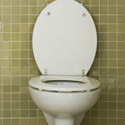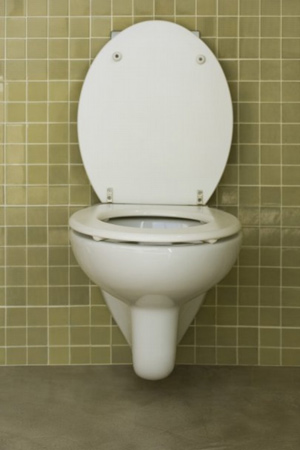
21 Sep Where Are The Most Household Germs?
Which Has More Germs, Toilet Seat or Kitchen Sponge?
CDC says public toilets are safe, but the anxiety remains.
“To sit or not to sit?” This is a practical question when confronted with a public toilet seat.
Understandably, most of us give a cursory glance or quick inspection before sitting down. You would be silly not to, given the wide array of activities that transpire in the public bathroom. It seems like a veritable minefield of germs waiting in there. Then you see those nifty paper toilet-seat covers and your fears are eased. Sani-Seat, one of the companies that manufactures toilet seat covers, claims a full 60 percent of us won’t sit on a public toilet seat. Is this paranoia at its finest in our Purel-drenched society?
It’s widely known that our kitchen sinks are far worse cauldrons of infection than our bathrooms. My old microbiologist professor used to remark that aliens would be perplexed to observe us preparing food in our filthy kitchens and then defecating in fairly clean toilets.

The Center for Disease Control and Prevention clearly states most viruses, bacteria and parasites are not transmissible from toilets.
Toilet Seats Are Safe
The Center for Disease Control and Prevention clearly states most viruses, bacteria and parasites are not transmissible from toilets. They also dispel the sophomoric rumor that pubic lice are eagerly there awaiting to jump upon your genitals. So the official government line is: Toilet seats are safe. (The CDC’s website does state that pinworms can be caught, however.)
I next searched the medical literature for validation and it is widely in agreement with the CDC. There are a handful of scattered case reports where people are infected by fluky events (like a toilet overflowing in a hospital room).
Common organisms acquired by contact like staphylococcus and streptococcus could be conceivably spread and you may become colonized by a specific strain. But your own strains of staph and strep probably offer you some degree of protection. It seems infections from toilet seats are a rare event and highly unlikely to cause disease if any organisms happen to be there.
Kitchen Sponges Are Filthy
The popular TV show, “MythBusters” looked at this issue a few years ago. Kitchen sponges were by far the filthiest item surveyed. Cell phones, light switches, computer keyboards, and money shared the next top spots. Toilet seats harbored the fewest bacteria and looked like a sterile operating room compared with kitchen sponges.
The Rest Of The Bathroom And Germs
So what about the rest of the bathroom? Literature is plush with frightening reports of what is aerosolized with each flush. A scenario far worse than anything you could imagine sitting upon. Some reports state older toilets sent fecal particles and infectious critters up to 20 feet. I prefer to pretend this is not an issue. Ignorance really can be bliss.
It is also recognized that the underside of the toilet seat harbors a worse scene than the side we sit upon. This is due to the evidently not-so-rare practice of neglecting the underside of the seat while cleaning the toilet. Why anybody would completely skip this is a mystery to me, but alas, they do.
Remember, most of this article is focused on the toilet seat itself. The bathroom doors, water knobs, and flushing levers don’t receive as much study and fanfare in this article. I’m not sure what lives there, but it can’t be good. So use a towel to turn off the water and keep pressing down the lever with the sole of your shoe. After all, everyone is probably doing it.
Dr. Derrick Adams is a Board-Certified Dermatologist and the Medical Director of Vita Dermatology and Laser Institute, a division of Lassen Medical Group in Red Bluff. His office can be reached at 530-528-VITA.

